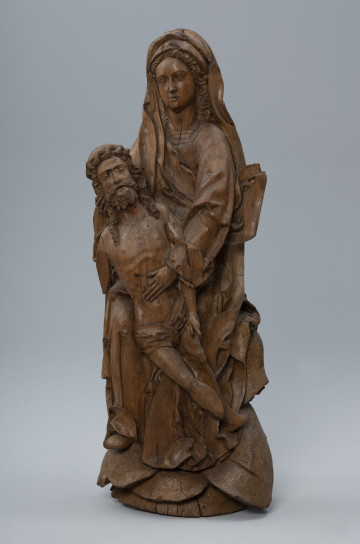
Pietà
circa 1520
National Museum in Szczecin
Part of the collection: Medieval sculpture of West Pomerania
The sculpture of Mary enthroned with the Child is the oldest of the preserved Marian cult statues from Western Pomerania. It represents the type of representation known as the Throne of Wisdom (Latin Sedes Sapientiae), popular especially among the Cistercian Order.
Mary was referred to as the Throne of Wisdom by St Bernard of Clairvaux (1090-1153). The term, taken from early Christian literary works, refers to the idea of Mary constituting the throne of the incarnate Logos – the Wisdom of God, in accordance with the dogma of her divine parentage.
The hieratic nature of the figures, typical of Romanesque art, was achieved through the static and almost schematic composition of the sculpture built from simple shapes, the minimalism of the gestures and the rhythmic modelling of the robes. This style reached Pomerania in the 13th century via Gotland, which was then the commercial and artistic centre of the Baltic region. Figures of this type were usually set in altar settings with a canopy structure.
The foundation of the sculpture on display is linked to the Cistercian Order of Kołbacz because of its origins. Gardno, where the statue was found, once belonged to the estate of what was the largest and most important abbey in Pomerania in the Middle Ages.
The sculpture is presented in the permanent exhibition Mystery of Light. Medieval art in Pomerania.
Kinga Krasnodębska
Author / creator
Object type
figure, sacred object, altar element
Technique
sculpture, polychrome
Material
alder wood, paint
Origin / acquisition method
acquisition
Creation time / dating
Creation / finding place
Owner
Muzeum Narodowe w Szczecinie
Identification number
Location / status